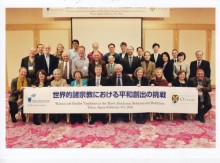Christianity and Islam in an Age of Transition: Violence or Healing?
Tokyo
A paper presented at the Conference
Warrior and Pacifist Traditions in the Three Abrahamic Religions and Buddhism
convened by National Centre for Peace and Conflict Studies, University of Otago, and Toda Institute for Global Peace and Policy Research (Tokyo).
Abstract
The paper argues that we need to move beyond the sterile disputes of the past when it comes to the interpretations of sacred texts. The scriptures offer a crucial point of entry to the religious domain, yet there is no denying the ambiguity that surrounds both the Biblical and Qur’anic texts. Christian theology, Islamic law and the history of both traditions have at times justified and at others condemned the use of violence.
Ours is a unique historical moment whose defining characteristic is the ‘globalisation of insecurity’. Christianity and Islam are both called upon to move ‘from legalistic prescription to holistic vision’. Far too often scholars and religious leaders speak of the religious message as if it had an eternal, unchanging quality to it, whereas in fact one of religion’s main tasks is to discern the ‘signs of the times’, to diagnose the ailments that afflict us at a given historical juncture. During this period of transition the challenge is to provide a vision of the future attuned to the realities of a globalising yet broken world.
To be able to do this at all well, we must move from discourse to practice. If Islam and Christianity are able to affirm a compelling vision of the human future, then visionary discourse must be accompanied by visionary practice. This means thinking long and hard about the impediments along the way, and what steps may be needed to overcome them.
The paper identifies three major impediments: the institutional fabric of religion itself, and especially the pedagogy which it embodies; the relationship of religion to political authority and power, social status and wealth, that is, the degree to which each tradition is equipped to speak truth to power; the failure of both traditions to engage in a sustainable dialogue and handle the challenge of majority-minority relationships.
…………………………………………….

